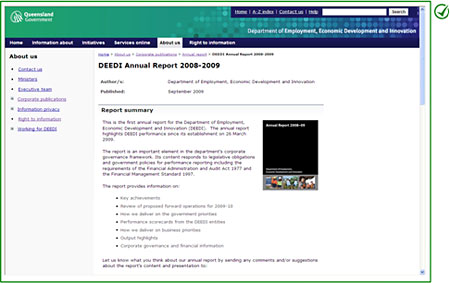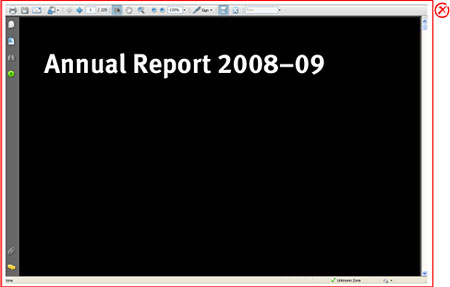Module 6: Checkpoint 1—HTML equivalents
| Conformance: Mandatory |
Requirements
Non-HTML documents must have either:
- an HTML equivalent (most preferred)
or
- an accessible non-HTML equivalent (such as RTF, ODF or DOC) with a summary page (refer to Checkpoint 2 and Checkpoint 3).
Exceptions to this include:
- Right to information (RTI) documents
- some forms.
For more information refer to the exceptions in this checkpoint.
Benefits of conformance
- Increased channel retention (online) and return on investment for government.
- Higher website usage, less reliance on more expensive channels and reduced information delivery costs.
- Increased customer experience and satisfaction.
- Improved accessibility and usability for users regardless of disability, technology or available bandwidth.
- Search results that are useful and relevant.
Risks of non-conformance
- Potential complaints or legal action against the Queensland Government.
- Increased service provision costs as users turn to more expensive information and service delivery channels.
- An unsatisfactory online experience, with some users unable to access government information and services, resulting in website abandonment.
Implementation advice
Explanation
HTML content is considered best practice for publishing online. Consistent use of HTML provides an online experience that is:
- seamless—as a user navigates between content and websites
- more accessible than many document formats
- for a wider range of people, including people with a disability and older people with changing abilities
- by a wider range of devices and operating systems (including mobile devices)
- better optimised for download and rendering performance than other document formats
- better optimised for reading on screen than many document formats.
Benefits to the government of publishing in HTML include:
- improved access to information and services
- greater search engine indexing (well-structured HTML content is more readily indexed and ranked higher by search engines)
- direct and indirect financial gains when replacing non-HTML documents with HTML
- decreased costs associated with personnel to maintain website and server capacity needed
- decreased content duplication (single source of truth)
- decreased need for creating multiple website versions for different devices
- decreased cost of providing other accessible formats
- decreased cost of language translation
- decreased cost of upgrading for new technologies
- preparedness for future web technologies (allowing content re-use)
- decreased risk of complaints or legal action.
Examples

User-friendly—the context of the site is maintained; HTML provides a seamless experience as a user navigates between content.

Not user-friendly—PDF opens to fill entire screen, navigation elements are not visible, content may be difficult to find; the user loses all context.
Exceptions to HTML publishing
Agencies must first conduct a risk assessment. A risk assessment should consider the following:
- risk of litigation to Queensland Government
- needs of the audience
- purpose of the document
- life span and popularity of the document
- the resources required to produce an HTML version compared to the resources required to create an accessible non-HTML format.
The following document types may be published without an accessible format, but must include contact details (e.g. email, phone) for a user to request alternative access to the information.
- Right to information (RTI) documents—documents included in an agency disclosure log under section 78 of the Right to Information Act 2009.
- Image-based documents such as maps, where there is no appropriate other format for displaying the resource (strategies for making pictorial content accessible should be considered, for example, by using qualified contractors to produce tactual maps and diagrams on request).
- Forms that are required by law to maintain their layout/presentation or to be completed in a specified way.
The Acts Interpretation Act 1954 (Section 49 Forms) states the following:
- If a form is prescribed or approved under an Act, strict compliance with the form is not necessary and substantial compliance is sufficient.
- If a form prescribed or approved under an Act requires—
- the form to be completed in a specified way; or
- specified information or documents to be included in, attached to or given with the form; or
- the form, or information or documents included in, attached to or given with the form, to be verified in a specified way;
the form is not properly completed unless the requirement is complied with.
As a result, the majority of forms can be reproduced in HTML. Online forms must conform to the mandatory requirements of Module 4: Online forms. A printable version of the online form can also be provided if required.
Forms not provided in HTML must:
- use an HTML summary page (Checkpoint 3 -Document summary pages and sections)
- be optimised for online publication (Checkpoint 4 - Document optimisation)
- meet file size requirements (Checkpoint 5 - File size requirements).


